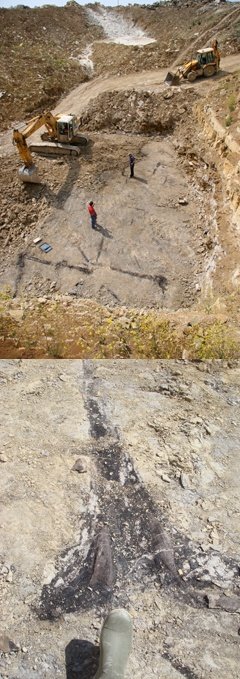Tree fossil find on Purbeck most significant since Lulworth
A tree fossil discovery at Lander’s Quarries on Purbeck in Dorset is being described by paleobotanists as the most significant find of its kind since the Lulworth fossils in the 19th century.
Recent quarrying at Lander’s has yielded the finds. In particular, fossil trees have been discovered at a different level to those already well known from Portland and the fossil forest at Lulworth.
The trees were growing about 130million years ago on the margins of a lagoon with a Mediterranean climate. Not long before the trees were growing, shell deposits had been laid down which have resulted in the excellent, sometimes fissile, limestone called Downsvein, which is used for roofing, paving and tombstones.
It seems the trees were killed by flooding (the same as seems to have happened at Lulworth). They stood in the water decaying before the inevitable fall. One of the fossil trees lies across a turtle, which at about a metre long is bigger than those usually found fossilised.
Bits of carapace (rather than the whole animal) are not uncommon, which is not surprising because dinosaur footprints and crocodile teeth are also to be found in the layer of clay that smothered the trees and this particular turtle.
The tree remains consist mostly of crumbly carbonaceous material, but some of the lower trunks and root masses have become silicified into stone as hard as flint.
Before this mineralisation occurred, the ever increasing weight of accumulating sediment tended to flatten them. Sadly, the silicified parts have fragmented into lots of small pieces, so preserving these fossils as found is difficult.
Samples of both sorts of woody material are currently being studied at the Geological Museum, London, and there is a realistic hope that it will be possible to determine the species and whether or not they are the same as the Lulworth / Portland trees.
A limited amount of the silicified wood and dinosaur footprints is being sold by the quarry.
Recent work using Purbeck stone from Landers and their associated company, Haysoms, includes paving at Christ Church Spitalfields, Temple Bar, Boxgrove Priory and Westminster Abby.
The choice in each case was influenced by the fact that Purbeck had been used before. Post-medieval Purbeck flooring is dominated by Downsvein simply because across most of Purbeck it tends to split into a convenient thickness for flooring. In the 18th century, the stone was used widely, particularly in coastal South East England. Some was sent further afield, even as far as America.
There is a recorded case of difficulty once in completing a floor in Virginia because the vessel taking the stone there had encountered such severe weather in mid Atlantic that some of its cargo of the Purbeck stone had to be jettisoned.

